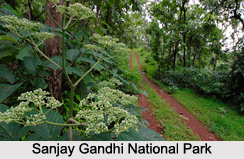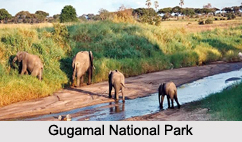 The state of Maharashtra is situated in the western part of India. The geographical terrain of this state is characterized by rivers, palm-fringed beaches, islands and mountains. The natural beauty of Maharashtra, along with world heritage sites, temples, bustling cosmopolitan cities, etc. draw tourists to this state. National Parks of Maharashtra are no exception in this regard. They also serve as tourism products of Maharashtra.
The state of Maharashtra is situated in the western part of India. The geographical terrain of this state is characterized by rivers, palm-fringed beaches, islands and mountains. The natural beauty of Maharashtra, along with world heritage sites, temples, bustling cosmopolitan cities, etc. draw tourists to this state. National Parks of Maharashtra are no exception in this regard. They also serve as tourism products of Maharashtra.
Sanjay Gandhi National Park
Sanjay Gandhi National Park is located in the northern part of Mumbai. It was established in the year 1969. It occupies about 104 square kilometers making it a large protected area. Ministry of Environment and Forests is recognized as its managing body. This national park serves as a home to over 1000 plants species, 251 species of migratory, land and water birds, 50,000 species of insects and 40 species of mammals. About 38 species of reptiles, 9 species of amphibians, 150 species of butterflies and a large variety of fishes are also protected here. This national park is known to be one of the most visited national parks in Asia.
Gugamal National Park
 Gugamal National Park is located in Chikhaldara and Dharni Tehsils of Amravati District. It was built in the year 1974 and is spread over an area of about 1673.93 square kilometers. It is a part of the Melghat Tiger Reserve. The flora of the national park comprises of forests, orchids, strobilanthes, medicinal plants, etc. Its faunal population consists of wild mammals, fishes, crocodiles and butterflies.
Gugamal National Park is located in Chikhaldara and Dharni Tehsils of Amravati District. It was built in the year 1974 and is spread over an area of about 1673.93 square kilometers. It is a part of the Melghat Tiger Reserve. The flora of the national park comprises of forests, orchids, strobilanthes, medicinal plants, etc. Its faunal population consists of wild mammals, fishes, crocodiles and butterflies.
Tadoba Andhari Tiger Project
Tadoba Andhari Tiger Reserve is located in district of Chandrapur. It is recognized as the oldest and largest national park of Maharashtra and one of India`s 43 Project Tiger Reserves. It was established in 1955 and the total area of the reserve is 1727 square kilometers. The floral pollution of the Tiger Reserve comprises of southern tropical dry deciduous forest with dense woodlands. Animals, insects, butterflies and reptiles comprise its faunal population.
Navegaon National Park
Navegaon National Park is located in the district of Gondia. It was established in the year 1955 and occupies an area of about 133.88 square kilometers. Maharashtra Forest Department acts as the managing body of this park. As of August 2016, 88 tigers are receiving shelter in the reserve and 58 tigers are being protected in the forests immediately outside the reserve. The attractive features of this national park are jungle safari, staying in a tree top house and riding a sail boat on the lake.
Other National Parks of Maharashtra
Chandoli National Park and Pench National Park are the names of the other National Parks of Maharashtra.











